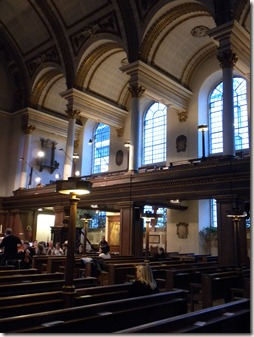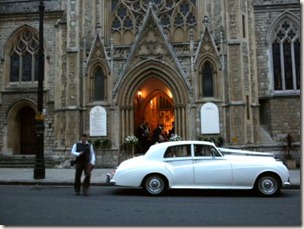Random photo from our visit to
South Kensington last night. Or, as we're now referring to it, Little Paris. South Kensington is where French people in London usually live (we were there to see a
French movie that was showing as part of the
UK Jewish Film Festival), though it's not clear which came first - the French population or the Continental feel. There are very few pubs in this neighborhood, but rather lots of small cafes and restaurants where the food is based around melted cheese, like these crepes we enjoyed at the
Kensington Creperie.

They also do a nice dessert...

Okay, now on to the recipes from this week. First, let me just say that I didn't have much work this week. My project is in a bit of a lull until January, which works out perfectly because I have to be back in the States for a month for my residency interviews, and because no one does any work in December anyway (too busy getting drunk at Christmas parties). So this week I had lots of time to plan and cook yummy things for dinner. And I figure I have to cook as much as I can this year, because when intern year hits I can kiss this cushy, quasi-academic lifestyle goodbye. We'll go by days of the week.
Sunday: Ottolenghi's chargrilled cauliflower with tomato, dill and capers. This was incredibly flavorful and fresh. I made some adjustments to his recipe, which I'll point out.

Ingredients: 2 tbs capers, drained and chopped; 1 tbs French wholegrain mustard; 2+ garlic cloves, crushed or chopped very fine; 2 tbs cider vinegar; 120ml olive oil; 1 small-medium head cauliflower, divided into florets; 1 tbs chopped dill (I actually left this out because didn't have any, and it was still fine); 50+ g baby spinach or spinach chopped small; 20g cherry tomatoes, halved; sea salt and pepper
1. Start roasting the tomatoes. The original recipe says to just throw the tomatoes in at the end, but ever since Laura introduced us to oven-roasted tomatoes we just can't get enough. Mix the cut cherry tomatoes with olive oil, salt and pepper, then put them in the oven (cut side up in a roasting pan) at 400.
2. Bring a large pot of salted water to a boil. In the meantime, make the dressing by hand or in a food processor. First mix the capers, mustard, garlic, vinegar and salt and pepper. While whisking or processing, add about 60ml olive oil in a slow trickle until the dressing is creamy (mine never became creamy, but it was still delicious).
3. When the salted water has come to a boil, add the cauliflower florets. Simmer for 3 minutes, then drain and allow the cauliflower to dry. When dry, mix with olive oil and salt and pepper.
4. To cook the cauliflower you can do one of two things - either cook it under a broiler or on the stove in a pan over very high heat. Either way, allow the pan to get very hot, then add the cauliflower, in several batches if necessary, making sure that the florets are not too cramped. Turn them the ensure even grilling.
5. In the meantime, rinse the spinach and steam it, using just the water clinging to the leaves. I just brought a small frying pan to high heat and threw the spinach in for a few minutes until it was wilted. Again, Ottolenghi just says to add the spinach, uncooked, at the end, but I think if you're not using tender baby spinach, you'll want to cook it a bit first.
5. When the cauliflower is grilled, transfer to a bowl and add the spinach, dressing, and tomatoes, which should now be cooked and getting wrinkly. Adjust seasoning and serve hot!
Monday: Beans and Rice with assorted veggies. I was really excited about making a red lentil soup, but when it came time to add the red lentils I realized we were out of them. Danny generously offered to go out and buy some, but I was feeling grumpy and thought we should just go with beans and rice, which turned out to be quite good. As I was planning on making soup, I thought I would make a nice veggie stock first, using all the extra green bits that come with farmers market produce.

Ingredients: olive oil; 1 large yellow onion; 4+ cloves garlic; red hot chili peppers to taste; 3 small celery stalks; 2-3 carrots; 1 red pepper; 1 cup brown rice; 1 cup pre-cooked or canned beans of any kind (or, or course, you could use lentils instead of the rice and/or beans); cumin, salt 'n' pepper. Cilantro and yogurt for topping. Assorted veggies/green for stock (see below)
1. Make veggies stock. I have no set recipe for this, but it generally looks something like this: gather all the inedible/tough bits of greenery (the spinach stalks, tops of celery, greens surrounding cauliflower), maybe add some carrots or parsnips, throw into a pot with bay leaves and/or fresh herbs, sea salt and a bunch of water, then cook until the water is green and fragrant and the green bits look like they've have all the vitamins drawn out of them. Discard the solid bits and voila - veggie stock! For the record, I used the skinny, leafy bits of a small bunch of celery, the tough bits of 2 leeks, the green, leafy bits that surround a head of cauliflower, the stems of a bunch of cilantro, and a handful of fresh sage and thyme.
2. Chop all the veggies in advance, then saute everything in olive oil, adding them in this order: onions until soft, garlic for about 30 seconds, then carrots and celery until softened, then red pepper. Add salt and pepper and cumin to taste (about 1 tsp cumin to start)

3. When all the veggies are soft (but not limp), add the cup of rice and stir to coat in oil. Add 2-3 cups of stock, depending on how liquidy you want the final product. Bring to a boil, then cover and simmer until rice is cooked. Adjust liquid as necessary.
4. Stir in the beans and season with salt and pepper to taste. Continue to add stock if you want, add additional spices as you wish. Serve with yogurt and cilantro.
Tuesday: Grilled coconut kale and rice noodles with peanut sauce. I discovered this
kale recipe in the NY times recently (along with a
funny article in praise of vegetables), and was excited to try it - I've spend the last few years trying to figure out a way to cook kale in a way that I *want* to eat, rather than just feel like I *should* eat. Well, this was a winner. Sometimes we're content just to eat a pile of greens for dinner, but after waking up hungry at 5am after eating only cauliflower for dinner on Sunday, I decided that the kale should be accompanied by something, and our old favorite of rice noodles with peanut sauce seemed the perfect companion. See above link for the kale recipe - but just a warning, the kale is supposed to marinate for 4+ hours, so plan accordingly! Also, there will be a lot of extra coconut marinade left when you're done. Save it! I used this extra for the coconut milk in the peanut sauce, and in Friday's dinner (see below). I also saved the kale stalks to use in a future stock (pun?), and ended up throwing them into Friday's dinner as well.
 Rice noodles with Thai peanut sauce, from “The Voluptuous Vegan”
Rice noodles with Thai peanut sauce, from “The Voluptuous Vegan”
Ingredients: 5-7oz rice noodles; 1 cup coconut milk (or extra coconut marinade from the kale!); 2 stalks lemongrass; 3/4 cup crunchy peanut butter; 2 tsp maple syrup; 2 garlic cloves, minced; 1/4 cup soy sauce; 2 tbs fresh lime juice; 1 tsp lime zest; 1 jalapeno; 1/2 tsp salt; scallions; cayanne pepper to taste; chopped peanuts, cilantro.
Additional note - I didn't use lemongrass, and it was just fine.
1. Place rice noodles in a bowl. Pour boiling water over and let sit 10 min.
2. If using lemongrass, combine coconut milk and lemongrass in a saucepan and bring to boil. Turn off heat and let steep for 10 min. Strain out lemongrass.
3. Whisk all other ingredients into the coconut milk.
4. Drain rice noodles and serve with sauce – toss to mix well.Top with chopped peanuts and cilantro, if desired.
Wednesday: Ottolenghi's (again!) Roast potatoes and Jerusalem artichokes with lemon and sage. Yum. Neither of us had ever eaten Jerusalem artichokes before, but they seem to be really big here (ie. our farmers market has them). They are a root vegetable and they have a much crunchier, fresher texture than potatoes, but don't have a very distinctive flavor, which means they absorb flavor nicely (the tofu of the root vegetable world, if you will). Back when I ate meat I really liked the aunt's lemon chicken, and I found that this recipe is a good replacement for it. I think next time I will add some onions at the beginning of t he roasting pan, so I encourage you to do the same. The recipe is not difficult, but spends a lot of time roasting, so plan in advance. A simple salad with fresh greens, pumpkin seeds and the ash-coated goat cheese was the perfect complement.
he roasting pan, so I encourage you to do the same. The recipe is not difficult, but spends a lot of time roasting, so plan in advance. A simple salad with fresh greens, pumpkin seeds and the ash-coated goat cheese was the perfect complement.
Ingredients: 1 lb Jersey Royals or other small potatoes; 1 lb Jerusalem artichokes; 4 garlic cloves, chopped; 50ml olive oil, 2 tbs roughly chopped sage; 1 tsp salt; 1/2 tsp pepper; 1 lemon; 1/2 lb cherry tomatoes; 1/2 cup Kalamata olive, pitted and sliced in half (I actually used green olives); 2tbs rough chopped flat leaf parsley.
1. Preheat the oven to 400. Wash the potatoes well and place in a saucepan. Cover with salted water and bring to a boil. Simmer for about 20 minutes, until semi-cooked. Drain, cool, then slice into rounds. Place in a large roasting pan.

2. Wash the artichokes well and cut them into slices about 5mm thick. Add to roasting pan. Add the garlic, olive oil, sage, salt and pepper to the vegetables. Mix with your hands, then place in the oven for 30 minutes.
3. In the meantime, thinly slice the lemon and remove the pits. After the 30 minutes of roasting add the lemon slices and stir. Roast for 20 minutes.
4. After the 20 minutes, add the tomatoes and olives, stir again and roast for 15 more minutes.
5. Remove from oven and stir in parsley. Serve hot.
Thursday: Leftovers :)Friday: Mixed vegetable curry, I guess I'll call it. This dinner was my attempt to use a bunch of veggies that had been hanging around the fridge all week, as well as the leftover spicy coconut milk marinade from the kale. It actually turned out as good as it was in my head! If you haven't made the kale but want to try this curry, you could just mix a can of coconut milk with 2 tbs lemon juice, 1 tbs salt, 1/2 tsp cayenne pepper, and 1/2 tsp paprika and I think you'd be okay.
Ingredients: 2 tbs vegetable oil, 4+ garlic cloves, 1 inch ginger root, 1+ hot pepper, 1 large onion, 2 zucchini, 2 carrots, 1 red pepper, 1 leek, leftover kale stems (optional), 2 cups water about 1 cup coconut milk marinade; salt and pepper. Oh, and rice noodles!
1. Chopping first: onions into thick slices, garlic, ginger and hot pepper into almost-paste, zucchini and carrots into half moons, leeks into thick strips, red pepper into chunks. Chopping everything first mean that you don't end up overcooking things because you're not done chopping the next ingredients (which has been a problem for me in the past).
2. More veggie stock! I mostly did this a) because I wanted to pre-cook the veggies and we don't have a steamer, and 2) because I thought I would need more liquid to add to the coconut milk. I basically did this: bring 2 cups water to a boil in a small pot. Add the carrots, cook for a few minutes until soft but not falling apart, remove from water with a slotted spoon and let drain. When water returns to a boil repeat with zucchini and kale stem. Now you have pre-cooked veggies and some delicious cooking liquid!
3. Heat the oil in a large pan. When hot, add the onions and stir until slightly soft. Add the garlic/ginger/hot pepper mix and stir until fragrant. Add the red pepper and leeks and cook until softened. Add the rest of the pre-cooked veggies, the coconut milk mix, and as much of the veggie stock as you wanted (depending on how soupy you want it). Save the rest of the stock for future cooking adventures. Simmer until everything is heated through and the desired softness, about 5 minutes.
4. In the meantime, boil water to cook the rice noodles according to their instructions. Usually this is bring the water the a boil, add the noodles and remove from heat. Let sit until noodles soften.
5. Pour curry mixture over noodles in a large bowl and slurp your way to happiness.

Well, there you have it - 5 yummy dinners that I hope you will enjoy, too!
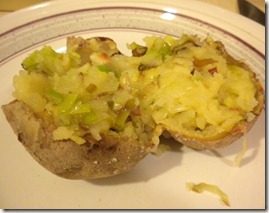 5) Once the potatoes are done, slice them in half length-wise, but don’t cut it all the way through. Spoon out the inside of the potatoes into a mixing bowl. Mix at least one tablespoon of butter (more if you’d like!) and the fried leeks with the potatoes, then mash until well-mixed. Spoon the mixture back into the potato skins. At this point, it should look like this picture on the right.
5) Once the potatoes are done, slice them in half length-wise, but don’t cut it all the way through. Spoon out the inside of the potatoes into a mixing bowl. Mix at least one tablespoon of butter (more if you’d like!) and the fried leeks with the potatoes, then mash until well-mixed. Spoon the mixture back into the potato skins. At this point, it should look like this picture on the right.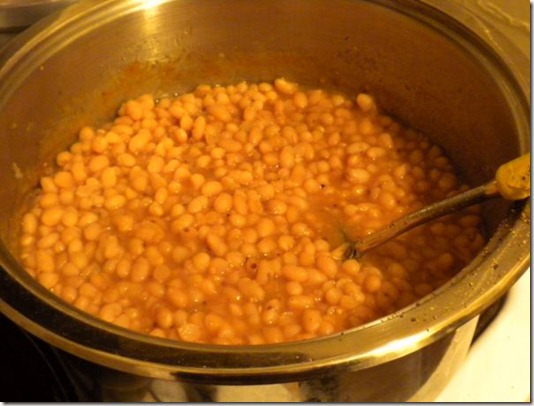
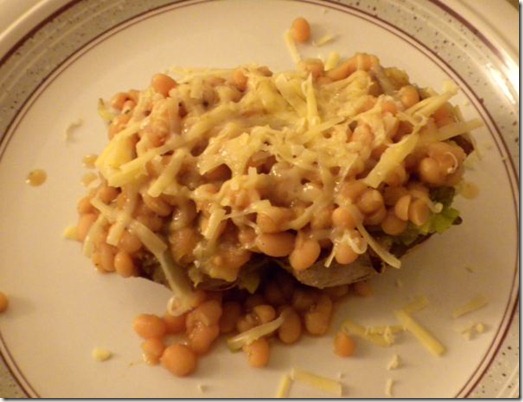






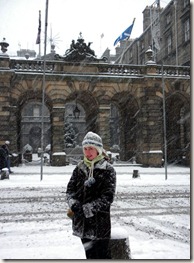

 In any case, the important part for our visit is that the Scottish Parliament, as parliaments typically do, has its own
In any case, the important part for our visit is that the Scottish Parliament, as parliaments typically do, has its own  As you might recall, the British transportation system ground to a halt on Tuesday. So while we anxiously waited to see whether we’d be able to get back to London (we did, on a train that cut over to the
As you might recall, the British transportation system ground to a halt on Tuesday. So while we anxiously waited to see whether we’d be able to get back to London (we did, on a train that cut over to the 



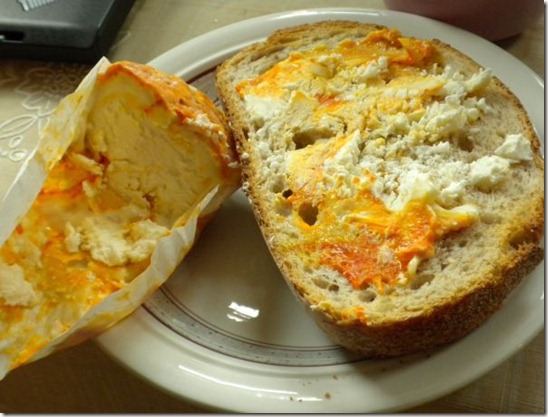
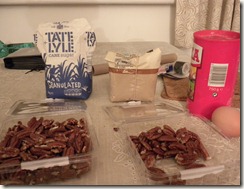
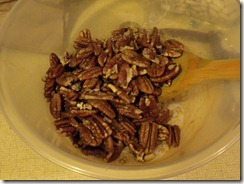
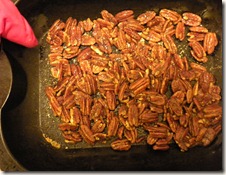

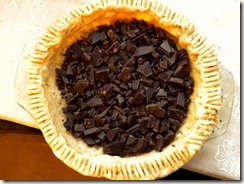
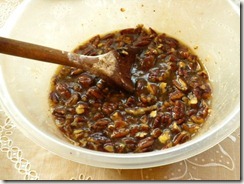
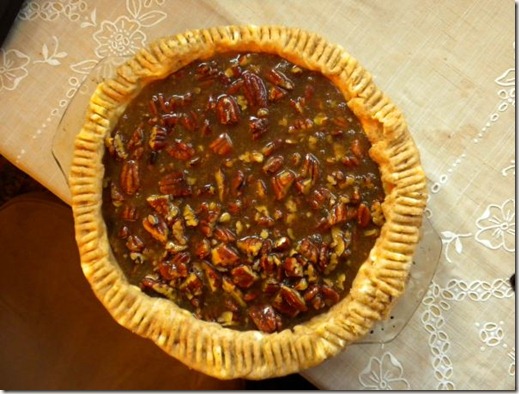
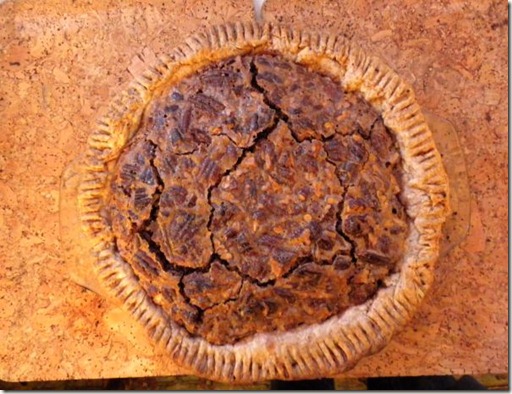
 The winner of the series gets a (replica of) trophy. And by trophy I mean a
The winner of the series gets a (replica of) trophy. And by trophy I mean a 

 Andrew Strauss – England’s South Africa-born captain and opening batsman. You can spot him by the wedding ring he wears on a necklace. In true captain form, you can expect plenty of bland cliches about taking each session/day/match one session/day/match at a time.
Andrew Strauss – England’s South Africa-born captain and opening batsman. You can spot him by the wedding ring he wears on a necklace. In true captain form, you can expect plenty of bland cliches about taking each session/day/match one session/day/match at a time.  Kevin Pietersen – England’s South Africa-born #4 batsman. Typically described with words like ‘brilliant,’ ‘mercurial,’ and ‘aggravating.’ Currently sporting a mustache for Movember, though he has some aspects of the pantomime villain, so I wouldn’t be surprised if he kept it. Fun facts: middle name is Peter. Born in Pietermaritzburg. You can’t make this stuff up.
Kevin Pietersen – England’s South Africa-born #4 batsman. Typically described with words like ‘brilliant,’ ‘mercurial,’ and ‘aggravating.’ Currently sporting a mustache for Movember, though he has some aspects of the pantomime villain, so I wouldn’t be surprised if he kept it. Fun facts: middle name is Peter. Born in Pietermaritzburg. You can’t make this stuff up.  Paul Collingwood – England’s Northern ginger batsman. Typically described as a ‘nurdler’ and ‘nuggety’. Which means, more or less, that he’s not very talented. He’s what American baseball fans would call ‘scrappy’. Look for him to hang around, as they say. Also one of the world’s top fielders, although the frequency of his drops is on the increase.
Paul Collingwood – England’s Northern ginger batsman. Typically described as a ‘nurdler’ and ‘nuggety’. Which means, more or less, that he’s not very talented. He’s what American baseball fans would call ‘scrappy’. Look for him to hang around, as they say. Also one of the world’s top fielders, although the frequency of his drops is on the increase.  Ian Bell – England’s Midlands ginger batsman. He seems to have recovered from his
Ian Bell – England’s Midlands ginger batsman. He seems to have recovered from his  Stuart Broad – One of England’s pretty young fast bowlers. Turns out he can bat a bit, too, though his dancing leaves something to be desired.
Stuart Broad – One of England’s pretty young fast bowlers. Turns out he can bat a bit, too, though his dancing leaves something to be desired.  Shane Watson – It is not possible to imagine someone looking more Australian. As my friend Ivan points out, all he needs is a surfboard under his arm. In spite of his hulking physique, known for frequent injuries and crying.
Shane Watson – It is not possible to imagine someone looking more Australian. As my friend Ivan points out, all he needs is a surfboard under his arm. In spite of his hulking physique, known for frequent injuries and crying. 





